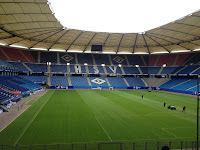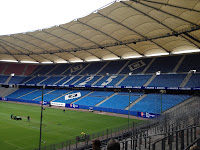Hamburger SV or Hamburger Sport-Verein eV to give them their full name, or HSV in short, are a sports club from Hamburg in northern Germany. The club were formed on the 29th September 1887 and offer baseball, badminton, basketball, bowling, boxing, cricket, darts, ice hockey, golf, gymnastics, handball and fitness to its members, though its football department is its foremost occupation.

The club was originally formed following a merger between Der Hohenfelder Sportclub and Wandsbek-Marienthaler Sportclub to form Sportclub Germania zu Hamburg. Germania began playing football from 1891, when six Englishmen with an enthusiasm for the game joined ranks. The modern club came about in 1919 after Germania joined forces with two other clubs in the city. Hamburger FC had been formed in 1888 and FC Falke Eppendorf in 1906. The new club took on the city colours of red and white as well blue and black from Germania playing its games at Sportplatz am Rothenbaum.
HSV quickly made an impact as they reached the 1922 national final against 1. FC Nurnberg. The teams could not be divided after two games, although in the replay the southern side were reduced to seven men after injuries and a sending off. HSV were awarded the title, but they handed back after persuasion in the spirit of the game. No title winner was declared for that year.

However, the following season HSV were not to be denied as Union Oberschöneweide (now 1. FC Union Berlin) were defeated as the Viktoria Trophy was lifted. Defeat in the final came the year after, but Rothosen (Red Shorts) were crowned champions once more in 1928. During the period of Third Reich rule, HSV were dominant in Gauliga Nordmark and then Gauliga Hamburg lifting a total of five titles.
After World War Two, Hamburg were placed in Oberliga Nord, where they became totally dominant. They were crowned champions in fifteen seasons out sixteen. They were defeated in the national final of 1957 and 1958 before lifting the title in 1960 with a 3-2 win over 1. FC Köln at the Waldstadion in Frankfurt, with two goals from their biggest hero Uwe Seeler and one from Charly Dörfel.

The following season saw HSV in the European Cup for the first time. BSC Young Boys and Burnley were defeated before FC Barcelona ended their run at the semi-final stage. A Seeler hat-trick won the DFB Pokal (German Cup) in 1963 against Borussia Dortmund, with the club becoming one of sixteen founder members of the Bundesliga shortly after, moving out of town to the 75,000 capacity Volksparkstadion at the same time. This venue had been rebuilt on the site of the old Bahrenfelder or Altonaer Stadion partly with materials from Eimsbüttel, a district of Hamburg destroyed under Allied bombings.
A second Pokal was added in 1976 following a win over 1. FC Kaiserslautern, with a young Manfred Kaltz in the line up. The following year HSV won the European Cup Winner Cup after seeing off RSC Anderlecht in the Amsterdam final. Kevin Keegan was signed from Liverpool to great effect shortly after, becoming a vital member of the team crowned Bundesliga champions in 1979 as head coach Branko Zebec was assisted on the pitch by Felix Magath, Horst Hrubesch as well as Kaltz and Keegan.
 |
| The Volksparkstadion in its prime |
The team continued on their excellent run, reaching the 1980 European Cup Final. Real Madrid were dumped out in the semi final before Hamburg returned to the Estadio Santiago Bernabéu for the final, only to go down 1-0 to Nottingham Forest. Keegan had moved on when another league title was added in 1982 under head coach Ernst Happel, as well as ending runners up in the UEFA Cup, when defeated by IFK Göteborg over two legs. Hamburg retained their Bundesliga crown the following season as well as putting right the wrongs of 1980 by lifting the European Cup, thanks to a Magath goal in the final against Juventus in Athens. To round off an amazing year, HSV also won the Intercontinental Cup defeating Grêmio.

The Volksparkstadion was rebuilt with new stands over the old athletics track, before being completed in 2000. On the pitch the club managed to qualify for the Champions League after third place finishes in 2001 and 2007. The stadium naming rights changed to bring in extra revenue. From 2001 to 2007 it was named the AOL Arena, then the HSH Nordbank Arena until 2010 when it was rebranded the Imtech Arena.
Many highly regarded coaches attempted to bring back the glory days to HSV including former players Felix Magath, Holger Hieronymus, Bruno Labbadia and Thomas Doll as well as Huub Stevens, Martin Jol and Frank Arnesen before Thorsten Fink took over the hot seat in October 2012 with players such as Heiko Westermann and Rafael van der Vaart at his disposal.

Hamburger SV will play in 1. Bundesliga in the 2013-14 season.
My visit
Monday 29th October 2012
I was on the final day of four very enjoyable days in Germany, where I'd seen four games and been to twelve clubs. The weather was closing in, but I was keeping warm having had a bit of a rush after a bit of a under estimation of travelling times around the city. I alighted at Stellingen SBahn station at just after 11.35 wanting to get to the Imtech Arena by midday for a tour around the stadium.
A wide path led me all the way from the station on a long brisk walk of over ten minutes through a park bordering an industrial estate, over Schnackenburgallee and to the arena. In a similar fashion to the Veltins-Arena in Gelsenkirchen it was raised above ground, so it looked enormous. The perimeter fence was open with signs pointing to the museum. A gent in the service centre pointed me in the correct direction and I was soon at the reception paying Euro 8 for my ticket. I was told that the tour was in German, but Birget the lady guide spoke English.
There was a Manchester City man and his son from England also taking the tour as part of a city break, so between us we managed to understand the areas we were been shown round. Football is an international language and I'd been on enough stadium tours in the past to take most of it in.

Our tour continued to the changing rooms, press centre and main foyer. Some first team players were arriving for training and we were asked to refrain from taking photos owing to their image rights! I had a little giggle at one point where the word hooligans was mentioned. A young lad wearing a Dynamo Dresden scarf was with us, and I said "Ja, Dresdener hooligans at St Pauli". He seemed to enjoy it!

This was a first class exhibition of souvenirs and memorabilia covering the clubs entire history. There were also some excellent videos to watch as I walked around. It was good to see Kevin Keegan's spell at the club was given plenty of coverage as well the matches with Burnley and Forest, as well as a poster from an early tour by Hartlepool United.

I chatted with the lad on the desk who regrettably informed me that was nothing left of the original Sportplatz am Rothenbaum. I left and went downstairs with the O2 World indoor arena opposite. The rain was falling, but my luck was in as the hourly bus arrived within minutes taking me back towards the city, where I took a SBahn train before linking with the UBahn to call once more at Millerntor to get some unexpected photos and to visit the souvenir shop.
HSV had been a fitting end to a superb four days.










No comments:
Post a Comment